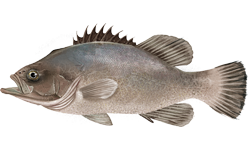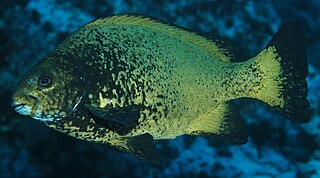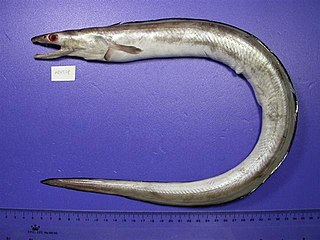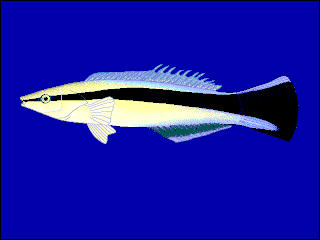
Sander is a genus of predatory ray-finned fish in the family Percidae, which also includes the perches, ruffes, and darters. They are also known as "pike-perch" because of their resemblance to fish in the unrelated Esocidae (pike) family. They are the only genus in the monotypic tribe Luciopercini, which is one of two tribes in the subfamily Luciopercinae.

The wreckfish are a small group of ray-finned fish in the genus Polyprion, belonging to the monotypic family Polyprionidae in the order Acropomatiformes.

The sea chubs, also known as rudderfish and pilot fish and in Hawaiian as enenue or nenue, are a family, Kyphosidae, of fishes in the order Perciformes native to the Atlantic, Indian and Pacific Oceans usually close to shore in marine waters.

The long-finned pike or yellowfin pike is a species of acropomatiform ray-finned fish, the only species in the genus Dinolestes, as well as the family Dinolestidae.

Dermatolepis is a genus of marine ray-finned fish, groupers from the subfamily Epinephelinae, part of the family Serranidae, which also includes the anthias and sea basses. They are found in the western Atlantic, Pacific and Indian Oceans.

The Muraenesocidae, or pike congers, are a small family of marine eels found worldwide in tropical and subtropical seas. Some species are known to enter brackish water.

Labroides is a genus of wrasses native to the Indian and Pacific Oceans. This genus is collectively known as cleaner wrasses, and its species are cleaner fish.

Muraenesox is a small genus of eels found throughout the Indo-Pacific. It currently has three described species as most species have been moved to other genera. Members are found in the Indo-West Pacific.

Cynoponticus is a genus of marine ray-fiined fishes belonging to the family Muraenesocidae, the pike congers. The fishes in this genus are found in the Eastern and Western Atlantic Oceans and the Eastern Pacific Ocean, with a single parapatric species in each region.

Heteromormyrus is a genus of freshwater ray-finned fishes belonging to the family Mormyridae, the elephantfishes. These fishes are found in southern and central Africa in Angola, Namibia, the Democratic Republic of the Congo and, maybe, Zimbabwe.
Chilorhinus is a small genus of marine ray-finned fishes belonging to the family Chlopsidae, the false morays. These eels occur in tropical waters
Neoconger is a genus of eels of marine ray-finned fishes belonging to the family Moringuidae, the spaghetti eels. These eels occur in shallow tropical and subtropical waters.
Kertomichthys is a monospecific genus of marine ray-finned fish belonging to the family Ophichthidae, the snake eels. The only member of this genus is Kertomichthys blastorhinos, a species known only from its holotype which was collected in the Atlantic Ocean in the vicinity of French Guiana.

Bangana is a genus of fish in the family Cyprinidae, the carps and minnows. It is distributed across much of southern and eastern Asia. Species live mainly in the flowing waters of tropical and subtropical rivers.
The yellow pike conger is a species of marine ray-finned fish belonging to the family Muraenesocidae, the pike congers. This fish is found in the Indian Ocean and the western Pacific Ocean.

Congroidei is a suborder of ray-finned fishes belonging to the order Anguilliformes, the eels. These eels are mostly marine, although a few species of snake eel will enter freshwater, and they are found in tropical and tempareate waters throughout the world.

Scorpis is a genus of marine ray-finned fish from the family Scorpididae which are native to the eastern Indian Ocean and the Pacific Ocean.

Gomphosus is a small genus of wrasses native to the Indian and Pacific Oceans.

Banjos is a genus of marine ray-finned fish, the only genus in the monotypic family Banjosidae, which is part of the order Acropomatiformes. They are native to the western Indian and the Atlantic coasts of Africa, and is made up of the three species of banjofishes.
Sauromuraenesox is a monospecific genus of marine ray-finned fish belonging to the family Muraenesocidae, the pike congers. The only species in the genus is Sauromuraenesox vorax which was described in 1889 by the British physician, naturalist and carcinologist Alfred William Alcock with its type locality given as the Bay of Bengal. This species is found in the northern Indian Ocean where it has been recorded off Oman, the Arabian and Andaman coasts of India, including Sri Lanka, east to Myanmar. This benthopelagic species is found over the continental shelf and upper slope over soft substrates at depths betwen 274 and 469 m.














